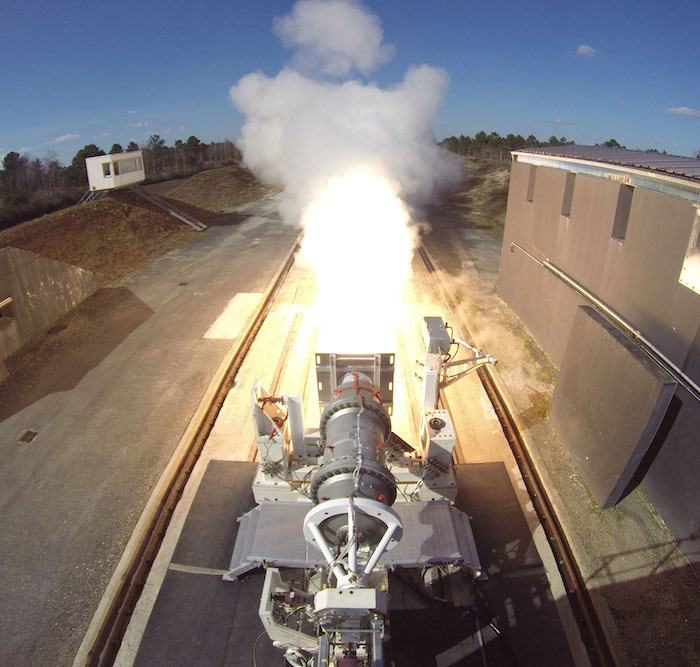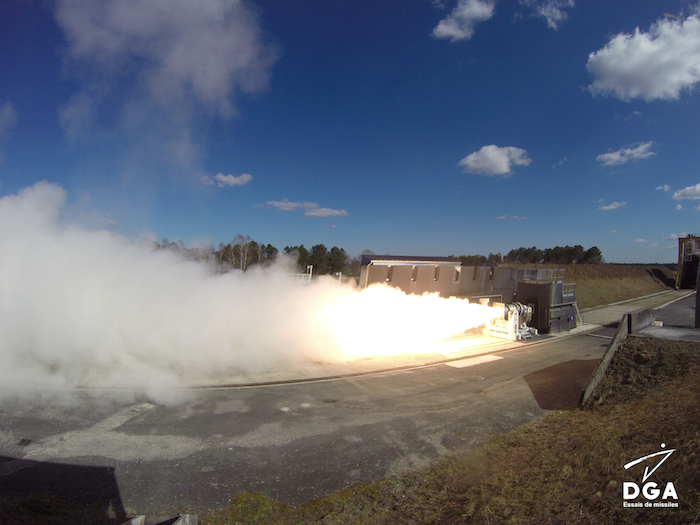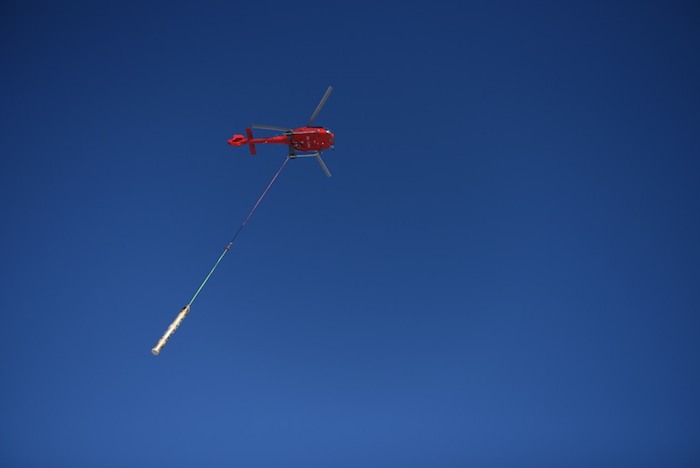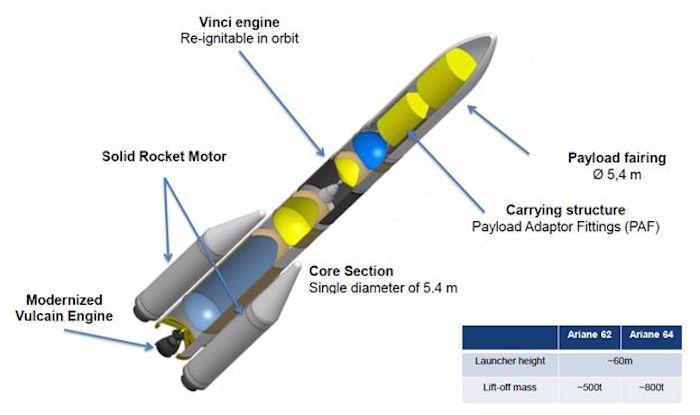.
19.04.2015

Ready, fire, test!
April 10, 2015
On March 5, the model reduces future Ariane 6 thrusters managed its "baptism of fire" on the military site of Saint-Jean-d'Illac near Bordeaux.
The burning lasted 23 sec. But nobody has seen "live". Only hidden cameras in white shelter (in the background and left on the picture) were in front of the test bed. Transmitted in a building 800 meters away, their images have allowed a hundred people to follow the firing of POD-Y engine, the experimental model to scale 1/5 of the future European launcher Ariane booster-6 Vega-C.
.

Engine before ignition. Its cylinder 70 cm in diameter and 3 m in length is filled with powder "Butalane-Z" and covered by 38 internal sensors. It is based on a balance (white bracket to the back), which recorded the slightest vibration during the test. It is surrounded by different measurement systems and protected from the flames of lifts by a heat shield (the black square in front). Credits: DGA missile tests.
.
Purpose of the test: measure the vibrations during the combustion of the powder, the solid propellant in the jargon. This combustion generates indeed pressure oscillations and thus thrust that can disrupt satellites during launches. "Too strong vibrations can damage electronic circuits embedded payloads on launchers or solicit nearby structures," says Eric Robert who oversees the Y-POD project to the CNES Launchers Directorate, in an integrated team with the Space Agency European (ESA). "On Ariane 5, there is a softener DIAS system that you want to delete Ariane 6."
.

The hot combustion gases were ejected about twenty meters. Credits: DGA missile tests.
.
To do this, POD-Y (with POD Pressure Oscillation Demonstrator) incorporates two new features: a new "magic powder" nicknamed "Butalane-Z" (with Z for Zen) and a new engine design, not segmented.
The goal of reducing by 4 vibration amplitude has he achieved? "It is too early to tell. The measures are being analyzed. But the 1st results show the integrity of the propellant and the ability to reuse some parts for other tests and an engine operation in accordance with the expected "explains project manager.
As a result, the ball is now in the industrial camp with a first shot-size expected in Kourou by mid-2017 and the first flight on a C-Vega in 2018. For Ariane 6, it was not until 2020!
.

Solid propulsion engines are one of the elements of the side boosters of Ariane. Boosters of Ariane 6 are significantly smaller than those of Ariane-5. But 64 Ariane 4, which will provide him a push 15% higher than that provided by the 2 boosters of Ariane-5. Credits: ESA-D. Ducros, 2014.
.
Did you know? This future propellant called P120C because it carries 120 tons of solid propellant (P = propeller and C = common to Ariane and Vega launchers 6-C).
Focus: POD-Y is a cooperative project between CNES and ESA. It was initiated in the preparatory phase Ariane-6 and financed at French level, in the context of future investment program. The design and construction of the motor are carried out under the responsibility of Herakles (a subsidiary of Airbus Safran Launchers) in partnership with ONERA.
---

Photo mystery planted in the snow ...
February 25, 2015
A giant dynamics stick? A cigar titanic? An extraterrestrial message? Not a microgravity experiment that could improve the performance of Ariane 6!
Last Sunday, Cryofénix experimental module is mounted up to 260 km altitude and spent 6 minutes in microgravity, or greater than 100 km altitude, before planting - gently - in snow Lapland with a parachute (the strings are visible in the image). He had previously departed from the base of Esranges in the north of Sweden.
.

The experimental module Cryofénix is hidden in this Maser sounding rocket 12.6 meters high which took off Sunday, February 22, 2015 from Esrange base, located 200 km north of the Arctic Circle. Credits: SSC-Esrange.
Inside, hundreds of sensors (temperature, pressure, liquid level ...) and 3 video cameras collected data on the behavior of 20 L cryogenic liquid hydrogen (ie at a temperature of -253 ° C) for 6 min microgravity. "This experience is a first in Europe. She had been done only once in the United States in the 60s, "said Vincent Leudière, project manager at the direction of CNES launchers.
.

A helicopter extirpated Cryofénix experimental module of the Swedish snow and brought him back to the Esrange base. Credits: SSC-Esrange.
.
Under what conditions liquid hydrogen bubbles do they form in space? What is their form? How are they distributed in the container? How is the temperature in the liquid? Here are some questions that this experience wants to answer. "It will allow us to test our models, compare them with reality. This is essential if we want reliable future European launcher Ariane-6. It will have the ability to place two satellites in different orbits. This requires two successive re-ignition of engines in flight during the ballistic phase. The liquid propellants are then mircrogravité for several hours. It is essential to study their behavior as finely as possible to optimize the design of cryogenic tanks for Ariane-6, and so winning performance, "said the engineer.
Focus: Cryofénix is a demonstrator developed since 2012 by CNES in collaboration with Air Liquide. It is part of a research program for 10 years on the study of the behavior of propellants in microgravity, with the experience already gained in towers in free fall (3 sec microgravity) and during parabolic flights by plane (30 Dry microgravity).
.

Quelle: CNES
---
Update: 29.01.2016
.
Europe settles on design for Ariane 6 rocket


The design for Europe's new Ariane 6 rocket has been settled and development will now move on apace, say officials.
The launcher is due to be introduced in 2020 and long-term will replace the Ariane 5 and Soyuz vehicles that currently operate out of French Guiana.
Airbus Safran Launchers, the company set up exactly one year ago to build the new rocket, is in the process of pulling together its subcontractors.
CEO Alain Charmeau said rapid progress was being made on the project.
"The basic design of Ariane 6 is now frozen to allow us to move into a more detailed design and production phase," he told BBC News.
"We have already signed some major contracts, and more will be signed in the coming days. And for those equipments not on the critical path, we will sign contracts in the coming months after running some competitions."
.

Work done this past year has established the key design and manufacturing principles
The company is a joint venture between the aerospace giant Airbus and the aero and rocket manufacturer Safran. The tie-up has yet to receive full and final sign-off from the French authorities because of corporate tax arrangements, but Mr Charmeau said this delay had made no impact yet on future Ariane developments.
"We were set up to manage Ariane 5 and 6 and we are doing that very efficiently, but it's true we can't maintain our current company configuration forever. But we will soon shift into a new configuration."
Ariane 6 will be a modular rocket that can be tailored to a wide range of satellite and mission types.
One version, known as Ariane 62, will loft medium-sized spacecraft into orbit - the kind of platforms that image and study the Earth.
The second version, known as Ariane 64, will put up the heavy telecoms spacecraft, which sit 36,000km above the equator.
line
Ariane 6 - A new European rocket for 2020
.

Next-generation rocket will be modular in design, offering two variants
Vehicles will lean on their Ariane 5 heritage but cost less to build
A new upper-stage engine (Vinci), already in development, will be used
Solid fuel boosters from the Vega rocket will provide additional power
A62 will tend to launch medium-sized government/science missions
A64 will launch the big commercial telecoms satellites, two at a time
In the short term, the rocket will be a one-time, expendable vehicle
line
Both variants will lean heavily on technologies already proven or under development for Ariane 5.
They will also borrow elements from Europe's small Vega launcher. The "2" and the "4" in the version names refer to the number of strap-on solid-fuelled boosters that do the initial lifting off the pad. These boosters will be the same as Vega's first firing stage.
The hope is that the commonalities between the different rocket types will help drive down costs.
Airbus Safran wants further economies by employing more modern methods of production and from streamlining assembly lines.
"We have chosen an optimised industrial organisation where we will try to maximise the rate of use of production tools. For example, there will be only one place for the machining of the big metallic structures. And we will of course be using additive layer manufacturing (3D printing) and processes like friction stir welding. We will be investing in new tools."
.

American companies are aggressively pursuing re-useable technologies
The question that is always asked concerning the future, is whether Ariane 6 will ever become a re-useable rocket.
The American company SpaceX already offers its Falcon vehicle for prices that significantly undercut the Ariane 5. And although Ariane 6 is expected to be 40-50% cheaper to produce than the existing model, SpaceX is promising to move the goalposts again by recovering and re-using its Falcons.
This same capability is also currently being demonstrated by another US company, Blue Origin, which has aspirations in the same markets as both Ariane and SpaceX.
There is no magic formula with one global validity
Jan Woerner, Esa director general
For its part, Airbus Safran does not envisage making Ariane 6 recoverable, not in the short term.
Mr Charmeau believes that different market conditions apply in Europe and the US, which means there will not be a single, winner-takes-all approach.
He cites, for example, the restricted procurement that exists in all major political blocs, which essentially bars foreign rockets from launching home institutional and government satellites. Nowhere is this more true than in the US, but in Europe too there is an "unwritten rule" that European states should use European rockets.
Mr Charmeau added: "And we have other specificities in Europe, such as the technology of propulsion, which is much better than the US one, both in solid and cryogenic propulsion. This allows us to launch [two satellites at once], which is another factor for competitiveness, maybe much better than re-usability - we will see in the future. And one characteristic, for example, is that we have only one (main) engine on the Ariane 64, whereas our competitor is going for re-usability because he is using much more engines. (The Falcon 9 has nine engines on its first stage.)
Rocket recycling
Long term it is hard to envisage Ariane shunning re-usability, and Airbus is studying a concept called Adeline that would modify the 62 and 64 variants to allow their main engine to fly back to a runway after consuming its launch propellant.
Whether Adeline, or some other re-usability concept, ever sees the light of day - and it would not be before 2030 - will ultimately come down to the attitude of European Space Agency member states. They fund the R&D of the Ariane programme and they may feel the American competition demands a response.
But like Mr Charmeau, Esa's director general, Jan Woerner, is not rushing to judgement.
"There is no magic formula with one global validity," he told reporters earlier this month.
"So, don't say 'this is the one and only solution'. We have to find a way to the best launcher for Europe; and we are doing so.
"I could talk for two hours about the advantages or disadvantages of re-usability. Is it appropriate for the European situation? I don't say 'no'; I don't say 'yes'. I just say 'we're discussing it'; we're looking into it in detail.
"But just look to your daily life: you are buying returnable bottles or one-way bottles, and obviously for both there is a market."
Quelle: BBC
5170 Views
